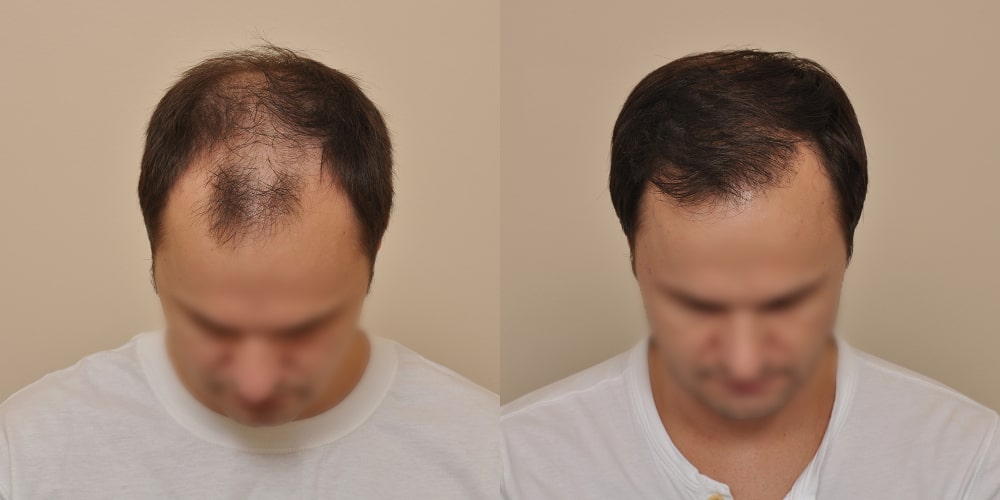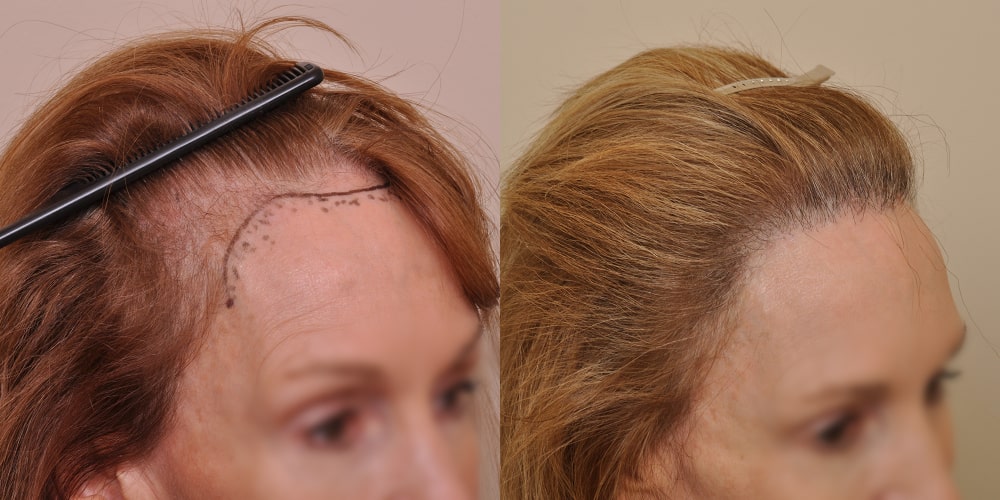FOLLICULAR UNIT EXTRACTION (FUE)
No scalpels, no stitches, no linear scarring
The latest tools and techniques in hair restoration
Follicular unit extraction (FUE) is a method of harvesting hair for a hair restoration surgery where individual hair follicles are removed one at a time from the donor area. The significant advantage of this method is that it leaves no linear scarring, so patients can wear very short hairstyles after recovery – a common limitation of the FUT hair transplant method.
Follicular unit extraction (FUE) is a method of harvesting hair for a hair restoration surgery where individual hair follicles are removed one at a time from the donor area. The significant advantage of this method is that it leaves no linear scarring, so patients can wear very short hairstyles after recovery – a common limitation of the FUT hair transplant method.
FUE DEFINITION AND OVERVIEW
Follicular Unit Extraction (FUE) is a revolutionary hair restoration technique that offers a minimally invasive solution to hair loss. Unlike traditional methods such as Follicular Unit Transplantation (FUT), which involves removing a strip of scalp from the donor area, FUE focuses on harvesting individual follicular units. Each unit typically contains one to four hairs, and the procedure involves extracting these units directly from the scalp using a micro-punch tool. This method leaves no linear scar, making it a popular choice for those seeking a less invasive option with natural-looking results.
FUE has transformed the field of hair restoration, providing patients with an alternative that minimizes discomfort and downtime while maximizing aesthetic outcomes. It is particularly advantageous for individuals who prefer to wear their hair short, as the lack of a visible scar is a significant benefit.
HISTORY OF FUE
Hair restoration has come a long way, with Follicular Unit Extraction (FUE) standing out as one of the most significant advancements in the field for patients seeking the least visible scar possible, especially those with very short hair.
1. The Birth of FUE: Early 200s
The early 2000s marked the birth of FUE, with the idea that it would be a less invasive alternative to Follicular Unit Transplantation (FUT). Dr. Ray Woods, an Australian physician, is credited with pioneering this technique. The initial approach involved using a small punch tool to extract individual follicular units directly from the donor area, minimizing scarring and reducing recovery time. Despite its potential, the early FUE procedures had to be staged into multiple sessions, which were time-consuming and required meticulous skill.
2. FUE Megasessions: 2004
In 2004, a significant advancement in FUE procedures was introduced by the Anderson Center for Hair’s own Dr. Kenneth W. Anderson and his colleagues; They developed the concept of FUE megasessions, where over 1,500 follicular unit grafts could be extracted and implanted in a single session. Dr. Anderson set a record by extracting and implanting 1,901 grafts in a single 12-hour session. This innovation required special organizational and technical skills, including the use of the Fox Test to evaluate the ease of extraction for individual patients. Click here read the full article, “FUE Megasessions – Evolution of a Technique” in Hair Transplant Forum International, 14(3):116-17, 2004.

3. Technological Advancements: Mid-2000s
As FUE gained popularity, technological advancements began popping up to streamline the procedure. Automated devices, such as the ARTAS robotic system, were developed to enhance precision and efficiency. These innovations significantly reduced the time required for extraction. The introduction of smaller punch sizes over the following years also minimized trauma to the donor area, leading to better healing and aesthetic outcomes.
The Anderson Center for Hair was the first practice in Georgia to offer the ARTAS Robot-Assisted Hair Restoration System, as well as the newest iX ARTAS Robotic System, a state-of-the-art, surgeon-controlled medical device that performs the follicular-unit excision (FUE) extraction process safely and effectively.
4. Refinement and Global Adoption: Late 2000s to Early 2010s
The late 2000s and early 2010s witnessed the refinement of FUE techniques and their global adoption. Surgeons worldwide began to embrace FUE for its minimally invasive nature and superior results. The technique became more accessible to patients, with clinics offering competitive pricing and personalized treatment plans. The emphasis shifted towards achieving natural-looking results, with surgeons focusing on the artistry of hairline design and graft placement.
5. State-of-the-Art FUE: Late 2010s to Present
The mid-2010s to the present has been a period of significant advancements in FUE technology and methodology. Devices like the WAW FUE System, have eclipsed larger, bulkier robotic tools and have become a primary tool for leading clinics, including at the Anderson Center for Hair. This system combines a tiny, motorized punch with a specialized foot pedal, providing precise control during the extraction process and the smallest scars available. The WAW FUE System features a hybrid punch that blends the advantages of both sharp and blunt punches, reducing the rate of follicular unit transection and improving graft survival. The extraction sites created by the WAW are a significant improvement over ARTAS extraction sites. Other notable devices include the NeoGraft and SmartGraft systems, which also enhance the efficiency and accuracy of FUE procedures.
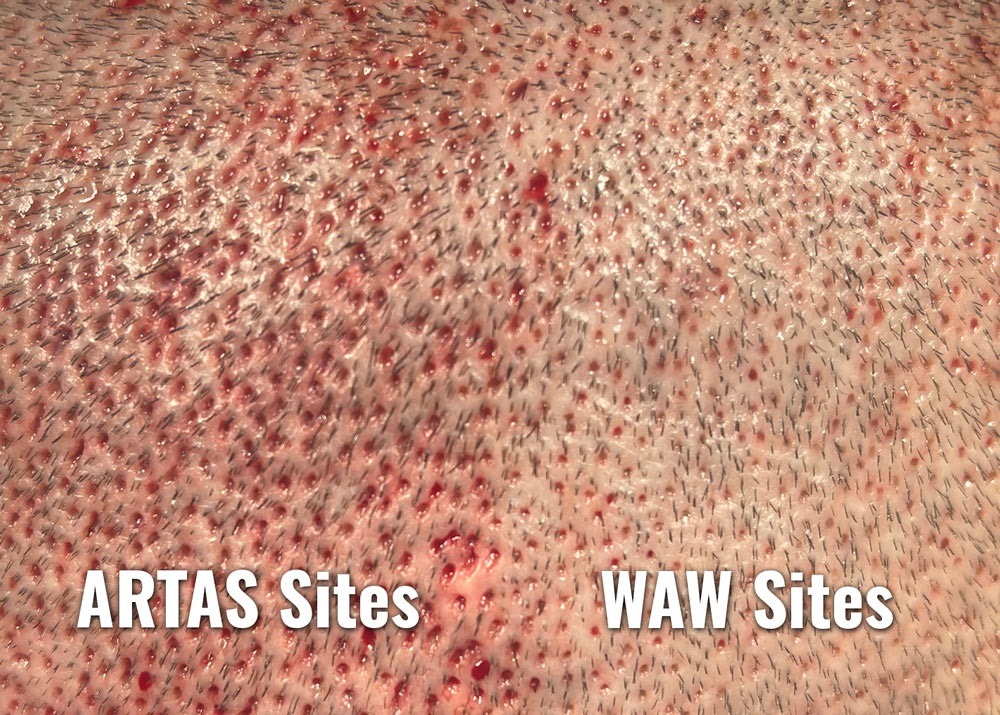
WHY CHOOSE FUE?
One of the primary advantages of FUE is that it does not result in a linear scar, unlike the FUT method. The tiny puncture wounds left by the micro-punch tool heal quickly and are virtually undetectable. This makes FUE an excellent option for patients who prefer shorter hairstyles and do not want visible scarring on their scalp.
Faster Recovery Time
FUE is less invasive than traditional strip harvesting, which means the recovery period is shorter. Most patients experience minimal discomfort and can return to normal activities, including non-impact physical exercise, within a few days. This quicker recovery time allows patients to resume their daily lives with minimal interruption.
Minimal Post-Operative Discomfort
Since FUE does not involve a large incision, patients typically experience minimal pain and discomfort following the procedure. The absence of sutures and the smaller size of the extraction wounds generally contributes to a more comfortable recovery experience.
No Need for Stitches
The micro-punch tool used in FUE creates tiny incisions that do not require stitching. This reduces the risk of complications and further contributes to a quicker and more comfortable healing process.
THE FUE PROCEDURE
1. Initial Consultation and Planning
Before the procedure, patients undergo a thorough consultation with Dr. Ken Anderson. During this consultation, the doctor assesses the patient’s hair loss pattern, donor hair quality, and overall health to determine their suitability for FUE. A personalized treatment plan is developed, including the design of the new hairline to ensure it complements the patient’s facial structure and aesthetic goals.
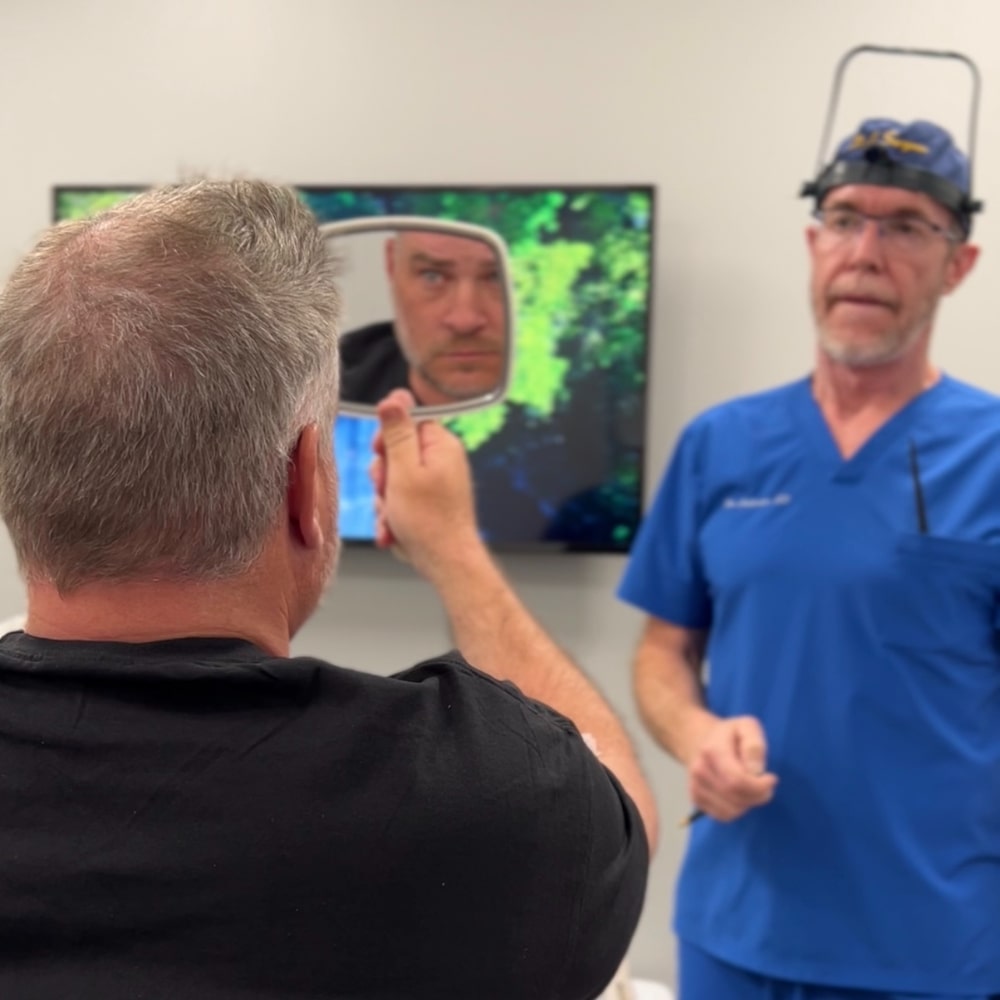
2. Preparing the Donor Area
On the day of the procedure, the donor area (typically the back or sides of the scalp) is trimmed to approximately 1-2 mm in length. This allows the surgeon to easily access and extract the follicular units. Local anesthesia is administered to the donor area to ensure the patient remains comfortable and pain-free throughout the procedure.
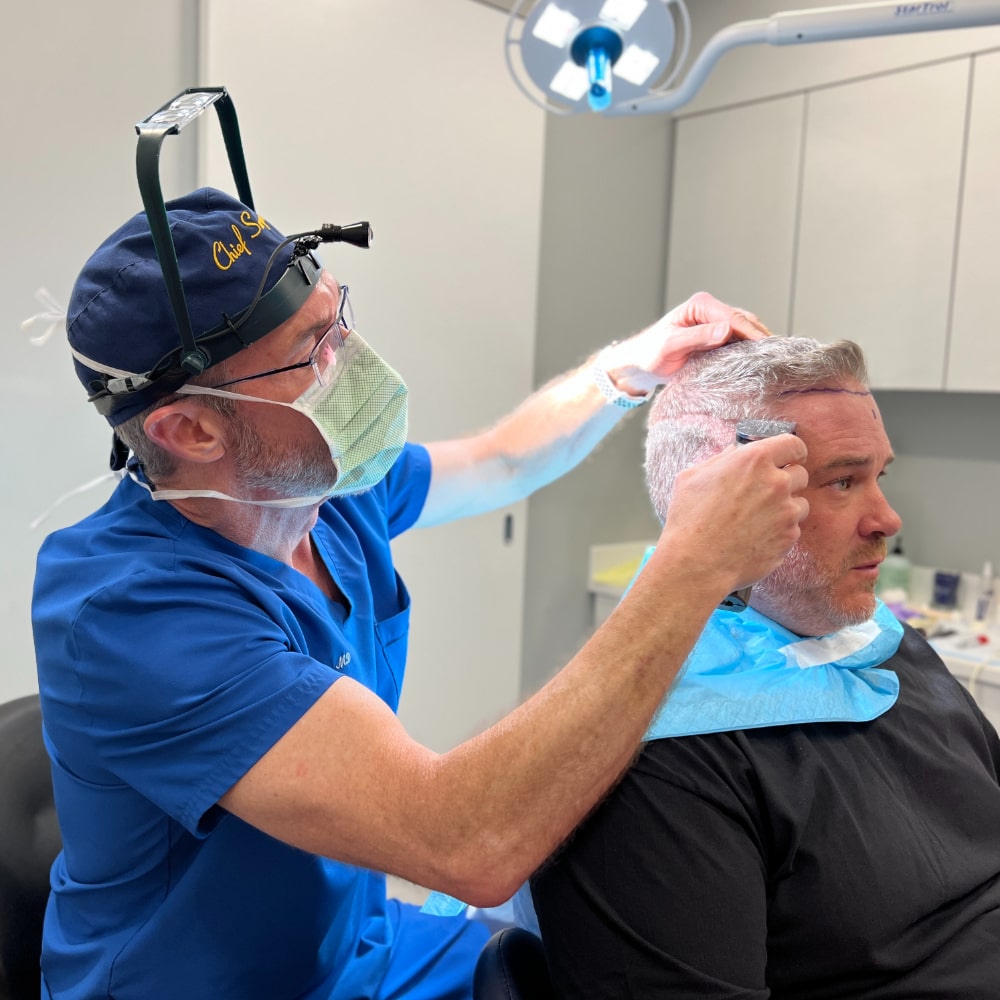
3. Extraction of Follicular Units
Using a specialized micro-punch tool called a WAW device, the surgeon makes tiny circular incisions around each follicular unit in the donor area. These units are then carefully extracted from the scalp. The micro-punch tool is typically 0.8 to 1.0 mm in diameter, minimizing damage to the surrounding tissue and reducing visible scarring. The extracted follicular units are kept in a sterile, temperature-controlled solution to maintain their viability until they are ready for implantation.
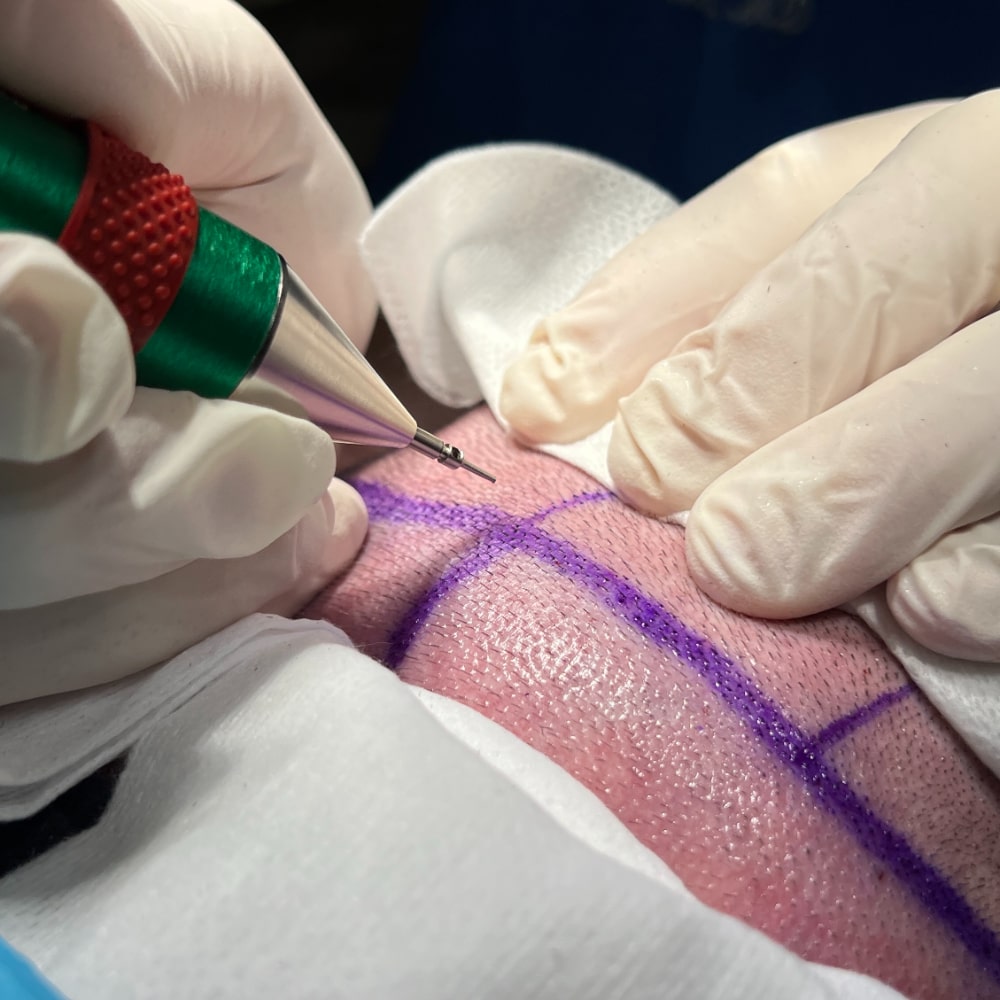
4. Preparing the Recipient Area
Once the follicular units are harvested, the recipient area is prepared. Local anesthesia is applied to this area to ensure patient comfort. The surgeon then makes small incisions in the recipient area, following the natural growth pattern of the patient’s hair. This step is crucial for achieving a natural-looking result, as the direction, angle, and density of the incisions determine how the transplanted hair will grow.
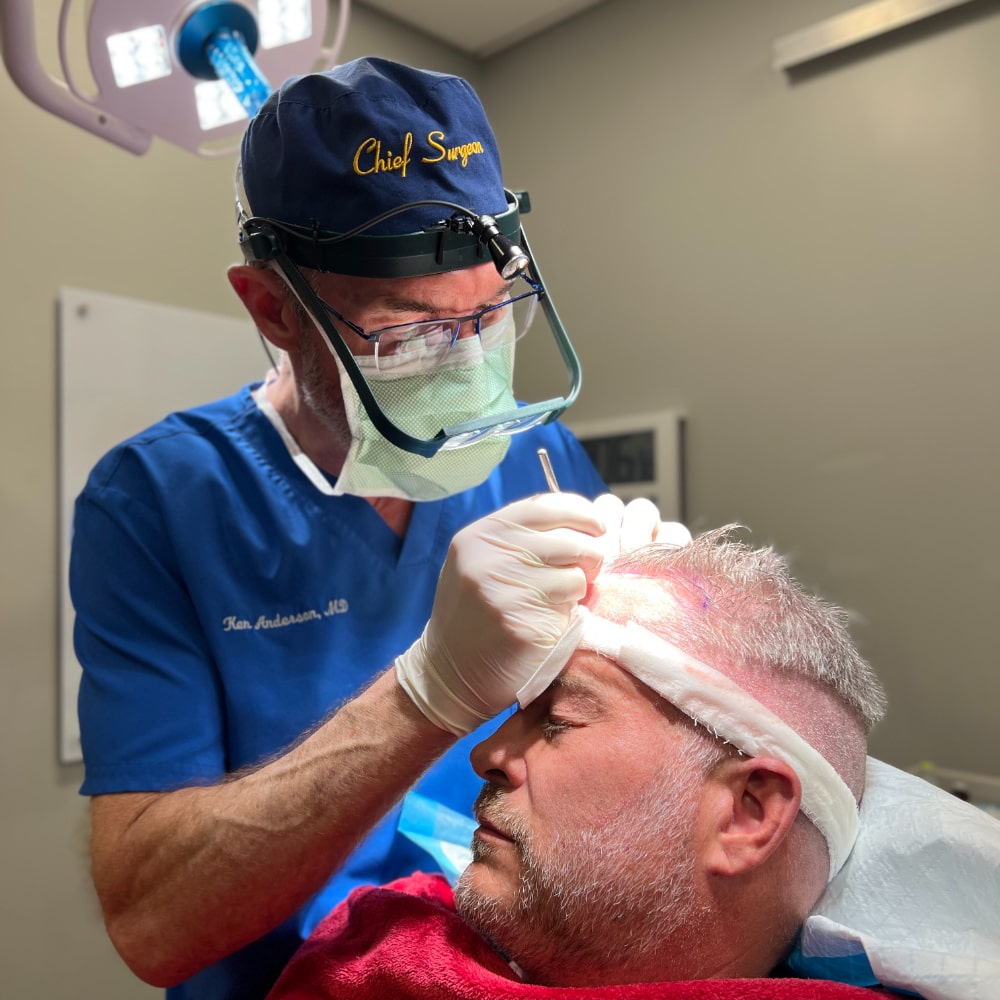
5. Implantation of Follicular Units
The extracted follicular units are meticulously trimmed under a microscope and then implanted into the recipient area. Each unit is placed into the pre-made incisions, with single hair grafts typically used along the hairline and multi-hair grafts placed further back to create a natural density and fullness. The placement of each graft is done with precision to mimic the patient’s natural hair growth pattern.
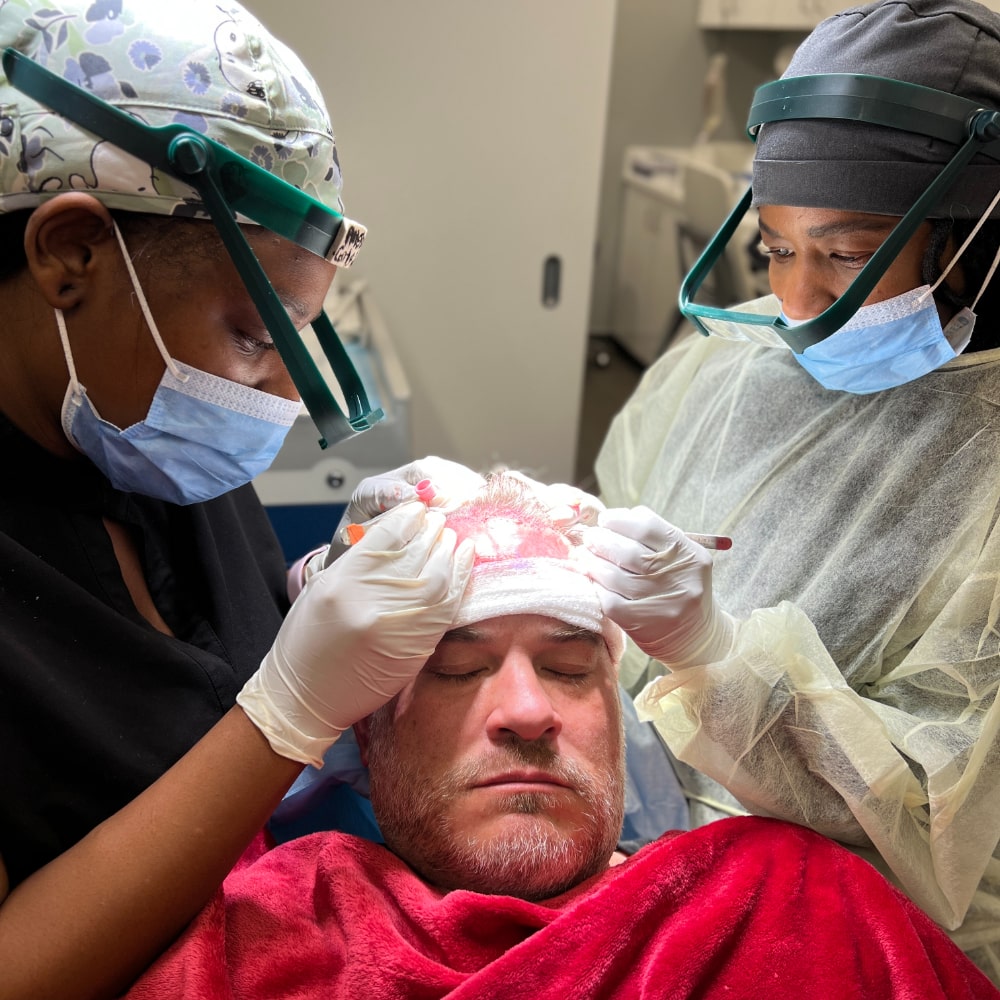
6. Post Procedure Care and Recovery
After the procedure, patients are provided with detailed post-operative care instructions. These include guidelines on how to care for the donor and recipient areas, medications to manage pain and reduce the risk of infection, and tips for promoting optimal healing and hair growth. Most patients experience minimal discomfort and can return to non-strenuous activities within a few days. The tiny incisions in the donor area heal quickly, typically leaving no visible scars.
7. Hair Growth and Follow Up
Patients can expect to see new hair growth starting around three months post-procedure, with significant improvements visible at six months. Full results are usually achieved within 12 to 18 months. Follow-up appointments are scheduled to monitor progress and ensure the transplanted hair is growing as expected.
For more detailed information and to see a real patient’s journey through FUE, visit Jason Johnson’s Patient Journey.
PROVIDING UNPARALLELED ACCURACY
The WAW FUE Device
At the Anderson Center for Hair, we use the innovative WAW Duo FUE System developed by Dr. Jean Devroye. This device combines a motorized punch with a specialized foot pedal to provide precise control during the extraction process.
The WAW FUE System features a tiny, hybrid punch that blends the advantages of both sharp and blunt punches, reducing the rate of follicular unit transection and improving graft survival. This results in higher quality grafts and better overall outcomes for patients.
The WAW device also includes a wireless handpiece and a multi-phase function that allows for customization of speed, angulation, rotation, and oscillation settings, ensuring our surgeons can provide optimal results tailored to each patient’s unique needs.


